The National Wildfire Coordinating Group has produced a four-minute video that they say summarizes the 2018 wildfire season.
Author: Bill Gabbert
Fire at Portales, New Mexico burns four structures
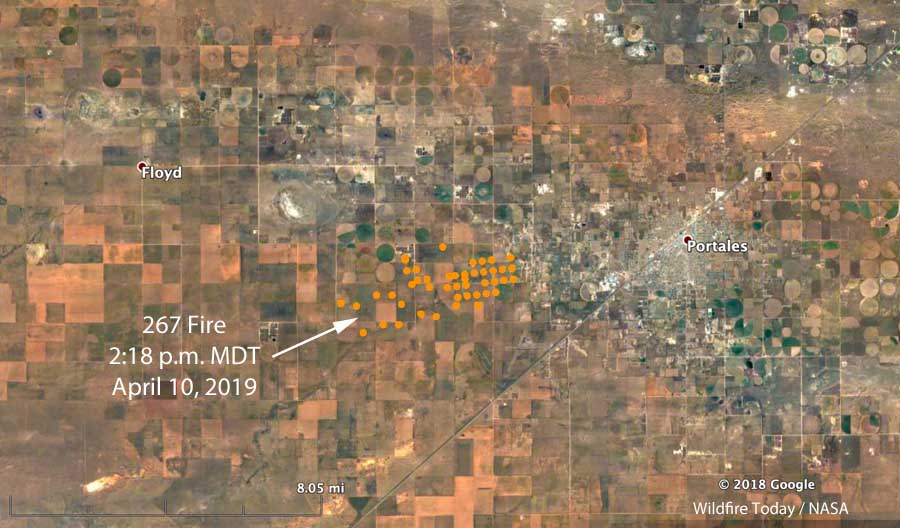
A wildfire that started 18 miles southwest of Clovis, New Mexico burned into the west side of Portales destroying at least four structures Wednesday afternoon. The “267 Fire” was reported at about 12:15 p.m. south of Highway 267 between Floyd and Portales during during extremely dry, windy conditions — 82 degrees, 5 percent relative humidity, and west to northwest winds of 30 to 40 mph gusting at 45 to 54 mph.
Officials established evacuation shelters at First Baptist Church and the Portales Memorial Building, in Portales.
The fire was contained late in the afternoon. Firefighters estimated the size at approximately 1,000 acres, but our very unofficial calculation using heat detected by a satellite shows it to be over 3,000 acres.
4 homes lost from the fire burning outside Floyd. One firefighter and one civilian were injured. 50+ MPH winds made it really tough conditions. It is CONTAINED. @KOB4 pic.twitter.com/pAQFd6Sr3J
— Megan Abundis (@meganrabundis) April 11, 2019
It was also very windy in Albuquerque, New Mexico Wednesday:
This afternoon’s weather balloon release was definitely interesting with the strong west winds! #nmwx @metskier15 pic.twitter.com/KtuRyKKdPN
— NWS Albuquerque (@NWSAlbuquerque) April 10, 2019
Former fire chiefs warn Australians about increasing climate threat
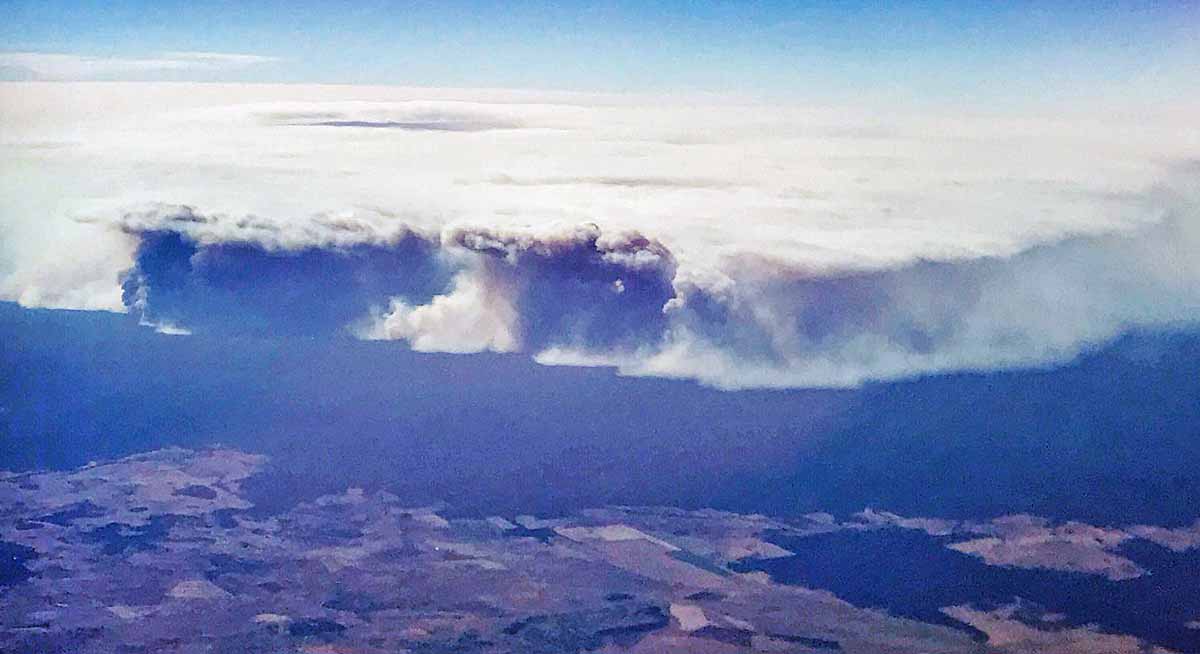
An article in The Guardian says 20 former fire chiefs in Australia are warning that the country and the emergency services are not prepared for the escalating threat from bushfires caused by climate change.
Below is an excerpt:
In a statement issued before a federal election date is announced, 23 former emergency services leaders and senior personnel have called on both major parties to recognise the need for “national firefighting assets”, including large aircraft, to deal with the scale of the threat.
The document calls on the next prime minister to meet former emergency service leaders “who will outline, unconstrained by their former employers, how climate change risks are rapidly escalating”.
The group also wants the next government to commit to an inquiry into whether Australia’s emergency services are adequately resourced to deal with increased risks from natural disasters caused by climate change.
Last year, in Australia alone, the NSW fire season began in early August, a heatwave led to fires in rainforest areas of Queensland in early December, and forest in Tasmania’s world heritage area caught fire in January, Australia’s hottest month on record.
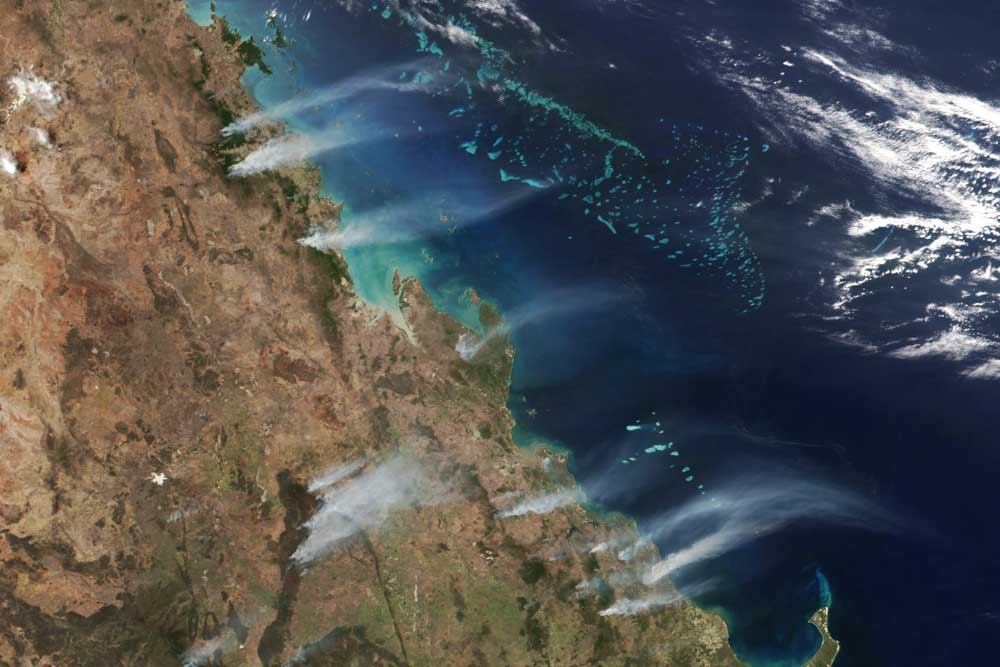
Senate committee discusses Forest Service budget issues with the Chief
5% reduction in USFS budget, fuel reduction funds, air tanker study, CFLRP, and LWCF
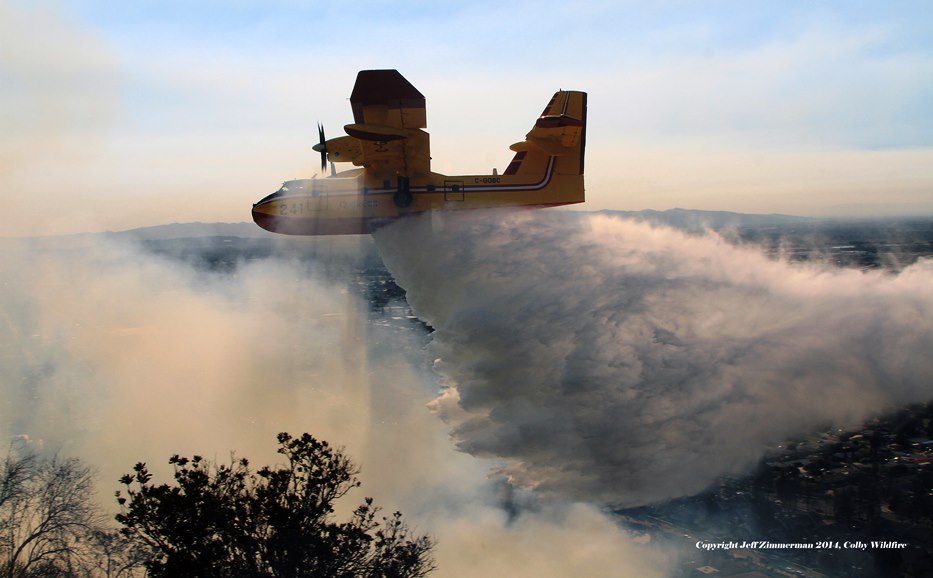
In addition to grilling the Chief of the Forest Service about hostile workplaces, several other issues were covered in a hearing Tuesday before the Senate Energy and Natural Resources Committee.
A video recording of the hearing is available at the Committee’s website. It begins at 19:48.
At 56:30 in the video Washington Senator Maria Cantwell asked Forest Service Chief Vicki Christiansen about the $545 million that was appropriated for fuel management in the recent omnibus legislation but was not mentioned in the administration’s proposed budget for FY 2020 which begins October 1. The Senator asked for assurances that the funds would still be available and would be used for that purpose. The Chief would not commit to the funds still being available, saying, “We will use whatever resources are given to the agency”.
The Chief reminded the Senator that the White House directed the Forest Service to cut its overall budget by five percent.
Senator Cantwell also mentioned very briefly at 59:00 in the video the availability of CL-415 water scooping air tankers but the issue was not discussed. The Forest Service, even though funds are available and a vendor offered the aircraft at a greatly reduced rate this year in a meeting with Chief Christiansen and Fire Director Shawna Legarza (according to our sources), the agency does not plan to have any scoopers on exclusive use contracts for the second year in a row. Historically the FS does not hold scoopers in high esteem even though they are used extensively in Canada and Europe. The 2012 Rand Study, which the agency attempted to keep secret (and did so successfully for two years), recommended a heavy emphasis on water-scooping air tankers and fewer conventional air tankers, which would have been a monumental shift in the paradigm.
Senator Murkowski said (at 1:39:30 in the video) that during a hearing a year ago the committee was told that results from the Aerial Firefighting Use and Effectiveness (AFUE) study would be released “soon”. The study, launched in 2012, is supposed to quantify the effectiveness of the various types of fixed and rotor wing aircraft when they are used on wildfires, in order to better justify the hundreds of millions of dollars spent by the Forest Service on firefighting aircraft. In FY 2017 for example, the most recent year with exact numbers available, the agency spent over half a billion dollars on fire aviation; $507,000,000. If ever completed and the results implemented, the study could make it possible to answer the question: “What are the best mixes of aircraft to do any fire suppression job?” Data collected from this study and other sources would be used to inform decisions about the composition of the interagency wildland firefighting aircraft fleet — to use the best, most efficient tools for the job.
However, to date no detailed reports have been released from the AFUE.
The Senator asked about the results of the study, now entering its eighth year. The data is being collected by four “observation modules,” each comprised of three qualified firefighters and a dedicated aircraft, to collect ground and aerial data at wildfires throughout the nation during fire season. In addition to the 12 firefighters, 3 analysts/managers evaluate the data. Christine Schuldheisz, a spokesperson for the USFS, has said the annual cost of the project is approximately $1,300,000.
Chief Christiansen, referring to the lack of any detailed results being released, said, “I absolutely share your concern and your question….. I am low on patience as well, Senator. This is a complex and labor intensive endeavor.”
Senator Murkowski: “But should it really require seven years to get a report like this?”
Chief Christiansen: “To have enough, when you have to take these assessment teams and have to be on the fire scene and to get enough data to get what the trend line is, it does take some time.”
The Chief then referred to a very small amount of preliminary data that was released in a two-page document in March which in a vague manner referred to the probability of success of direct vs. indirect attack by aircraft. This was was reported by Fire Aviation April 8, 2019.
Senator Murkowski asked the Chief to have more details from the AFUE study when the Committee holds their annual fire outlook hearing in about a month.
Since after seven years the Forest Service has not released any significant data about the study, a person has to wonder what have they found that is so embarrassing, controversial, or perhaps critical of specific models of aircraft, retardant products, or vendors?
Some people think the Forest Service will never release the full results of the AFUE study.
The Committee might have to subpoena the data.
Later in the hearing (at 1:43:30) Colorado Senator Sen. Cory Gardner referred to the study, saying in his rapid-fire speaking style: “There is a technical term I want to use to describe the length of time it is taking to get that study done, and it is Bunk! I’m sorry, it’s just a bunch of Bunk that it has taken seven years to get this done. We fought a world war in four years, we built the Pentagon in 16 months, we can’t do a study in 2 years, 1 year, 3 years, 4 years, maybe 5 years? It has taken seven years to do this? In the meantime we have western states that have had significant and catastrophic fires. I understand it’s important to get the information right. But doggonnit, someone needs to get a fire lit underneath them to get something done on this study.”
New Mexico Senator Martin Heinrich expressed concern that the Administration intends for both the Collaborative Forest Landscape Restoration Program (part of the Forest Service) and the Land and Water Conservation Fund (under the Department of the Interior) to be unfunded beginning in October. Again, the Chief mentioned that the White House directed the Forest Service to cut its overall budget by five percent.
Referring to the fact that the “fire fix” has reduced the necessity for the Forest Service to borrow funds from unrelated accounts to pay for fire suppression, Senator Heinrich said, “We’re giving you the tools, you’re not using the tools we are giving you.”
Forest Service Chief Christiansen testifies about harassment within the agency
Senator: “Making sure we have good policies in place doesn’t make a difference on the ground unless and until that culture is changed.”
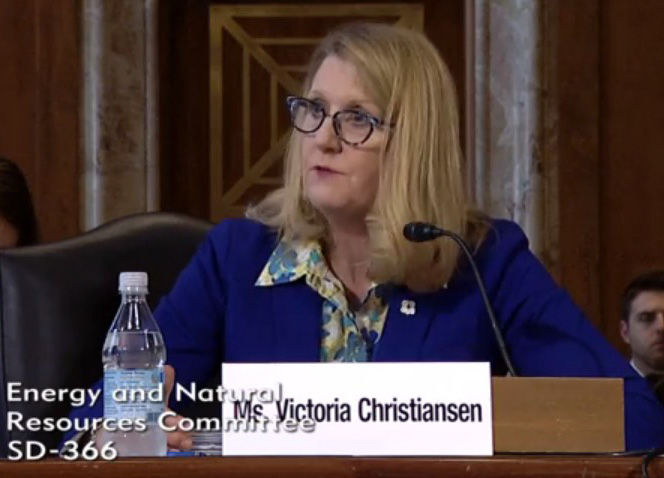
In a hearing before the Senate Energy and Natural Resources Committee today the only witness, Forest Service Chief Vicki Christiansen, was there to defend and answer questions about the administration’s proposed budget for the agency in the fiscal year that begins October 1, and to address any other topics introduced by the senators.
In this article we will cover the six and a half minute portion of the hearing in which harassment and an unhealthy working environment was discussed. And we have the reaction from Abby Bolt, a former Battalion Chief on the Sequoia National Forest in California, who sent an open letter to Sonny Perdue, Secretary of Agriculture, and Vicki Christiansen, Chief of the Forest Service, saying her resignation was effective immediately due to these issues.
In a separate article we will address other topics discussed in the hearing, including an overall five percent reduction in the Forest Service budget, defunding the Collaborative Forest Landscape Restoration Program and the Land and Water Conservation Fund, what happened to $545 million appropriated for fuel reduction, and the results from the Aerial Firefighting Use and Effectiveness (AFUE) study.
A video recording of the hearing is available at the Committee’s website. It begins at 19:48.
After opening statements from Senator Lisa Murkowski, Senator Joe Manchin, and Chief Christiansen, the first two questions were about the article which was published on Wildfire Today 15 minutes before the hearing started that was about the Battalion Chief on the Sequoia National Forest, Abby Bolt, who resigned.
At 37:00 in the video, Senator Murkowski read passages from the article.
Senator Lisa Murkowski, Chair of the Committee
“The headline is, “Forest Service Battalion Chief resigns in open letter to the Secretary of Agriculture”.
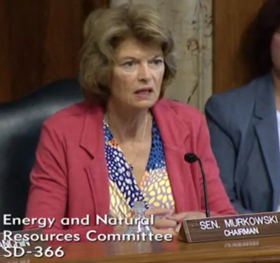
“It details that a woman who has been serving for 22 years in the U.S. Forest Service has resigned because in her words, she said Forest Service leaders have “failed to demonstrate moral courage by adhering to high ethical standards, and choosing the difficult right over the easy wrong helped me in determining my decision to resign.”
“You’ve indicated that things have changed within the Service. This is obviously a current event here, and so the question to you is why is this continuing to happen? Have the reforms that you have just briefly touched on [in your prepared statement] not yet been put in place? What is causing a continual deterioration within the workforce there?”
(From Bill: Chief Christiansen appeared to be prepared for the question and occasionally referred to notes as she responded.)
Chief Vicki Christiansen:
“Thank you Madam Chairman. I’m unable to speak directly about individual cases, and I assure you, things of the past we are looking at closely and we are learning and we are making corrections at every turn of the way. What we have done in the last year is I have set up a Work Environment and Performance Office with our most senior executives overseeing this work. This is a best practice in both private and government sectors. We are committed to results. It is a three-prong approach. First about accountability. Second is about prevention. Third is about a sustainable change in behavior and and agency culture.
“Many things we are doing. We are continuing to listen to our employees, we are revising our anti-harassment policy. We are holding supervisors accountable that do not report within a 24-hour period. We have increased our resources for followup and investigation, and we aggressively addressed many incidents of harassment with 23 removals, 5 demotions, 42 suspensions, and 166 other actions. We’ve added case managers and we’re working with OIG to identify and implement the best practices for measuring success, because all agencies really want to know what are the true measurements of success.
“In the prevention, we have instituted a no alcohol in any Forest Service seasonal housing starting this field season. We’ve increased our conflict management and prevention center resources, and we are delivering bistandard intervention training. When our employees spoke to us they said we need better skills in how we speak up early in when someone feels offended or when they feel there is inappropriate behavior. And we are improving organizational behavior and culture by having an ethic to stop the silence. If we can’t talk about it then we can’t fix it. And we are asking folks to be empowered to listen and learn and have incorporated employee advisory groups at the national level and across the service.
“We’ve incorporated our first ever code of conduct and agency core values. This is in every supervisor’s performance standards, and they will be held accountable in how we are reshaping the culture of the Forest Service.”
Senator Murkowski:
“Well Chief I appreciate what you have detailed. I am concerned, though, that even given the many steps that is is clear that you have put in place, when you have a 22-year veteran, someone who has achieved a position as Battalion Chief, when you have someone like that saying enough is not being done we still have a failure within your system. We still have a level of harassment or assault that clearly is not acceptable. So I would do more than urge you, as a Chairman of a Committee and as an American, I would tell you making sure we have good policies in place doesn’t make a difference on the ground unless and until that culture is changed. And I don’t want to pin everything just on one story that has appeared today but I think you know that internally the agency remains troubled. So put the policies in place as you are, but when you say there is accountability there has to be strict accountability because you can’t continue to have these levels of wrongdoing within our agency.”
Chief Christiansen:
“We have more to do Senators and I am absolutely committed with urgency.”
After Abby Bolt, the Battalion Chief who resigned, saw a video of the hearing, we asked for her reaction. She wrote:
“I was not aware of the hearing that was scheduled for today until after the Wildfire Today article. As I watched the senator quote my letter it brought tears to my eyes knowing that people at all levels across the nation are truly listening. When I heard Chief Christiansen respond I was overcome with a deep pain in my heart. I have been reaching out to her since she became Chief, offering solutions for our agency including a strong social media effort to inspire and motivate all federal employees to improve their work environment. I actively requested, formally and informally, to not be forced to remain in a proven hostile work environment as I worked through the processes in place meant to deal with harassment and discrimination. Nothing was ever done to improve my toxic work environment and I strongly feel Chief Christiansen could have made a difference. The administrative harassment only continued.
“Since speaking to the media last year and revealing an assault that happened on a fire assignment in more than one interview, no one from my agency officially reached out to me in any way, not even to ensure they weren’t liable or to find out how to prevent anything in the future. They did not seem to care or be interested in learning from the incident. I was worried that a landslide of inquiries would be required and prepared myself for the stress. However, I felt zero support just as I feared I would back when it happened which drove me to push forward in silence. The administrative harassment only continued. Vicki was aware of everything, yet she did nothing, at least not that I was made aware of.”
Forest Service Battalion Chief resigns in open letter to the Secretary of Agriculture
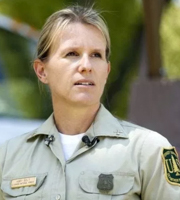
A wildland firefighter resigned last week after serving for 22 years in the U.S. Forest Service. Abby Bolt sent a letter to Sonny Perdue, Secretary of Agriculture, and Vicki Christiansen, Chief of the Forest Service, saying the resignation was effective immediately. She had risen through the ranks to the Battalion Chief level, becoming a District Assistant Fire Management Officer on the Kern River Ranger District of the Sequoia National Forest in California.
In a version of the letter that was posted on the Up in Flames website, Ms. Bolt said Forest Service leaders “failed to demonstrate moral courage by adhering to high ethical standards, and choosing the difficult right over the easy wrong helped me in determining my decision to resign.”
Below is an excerpt from the letter, used with permission:
I had high hopes to continue my fire career as a strong leader, proving to my son that I could be an exceptional mother, while managing a fire program and working on emergency incidents of all complexities. Little did I know, I would encounter a toxic dynamic of leadership that made my job, which was my life, a complete misery. The repeated statement by my management, “if you don’t like it you can leave” is what motivated me to hang on for so long, tolerating a manipulative style of management while continually looking for angles to successfully turn this toxic work environment around.
My parents, worked far too hard for such an amazing piece of land for me to simply be pushed away to another agency location because of a few people in managerial positions, who care more about maintaining and consolidating their power than they do about their employees. Sadly even my parents worry about retaliation. They are afraid someone may find a way to harm them as a way to hurt me. When they shared that with me it broke my heart, but proved to me how detrimental my situation has been.
But is that what you want? Quality individuals to leave dangerous work environments because they know that option is safer than speaking up? So far, the loud and clear answer I have seen and heard is YES. I simply can’t see how the USFS and USDA will ever improve with that mentality.
Ms. Bolt told us that the version of the letter sent to Mr. Perdue and Ms. Christiansen was more detailed. “I named names and listed some of the disgusting behavior occurring by my supervisors and supported by employee relations. My attorney thought it best [to hold] some of that back from the public version.”
She said she created the “Her Brotherhood” podcast and the Up in Flames website, “So that hard truths could be told and people could safely share and comment anonymously without being retaliated on. I hope it inspires others so that when they feel they are going down in flames, they instead fly up.”
Forest Service Chief Christiansen is expected to testify today, April 9, from 10 until 12 a.m. EDT before the Senate Energy and Natural Resources Committee “to examine the President’s budget request for the Forest Service for Fiscal Year 2020.” These hearings are usually live-streamed at the link above.
